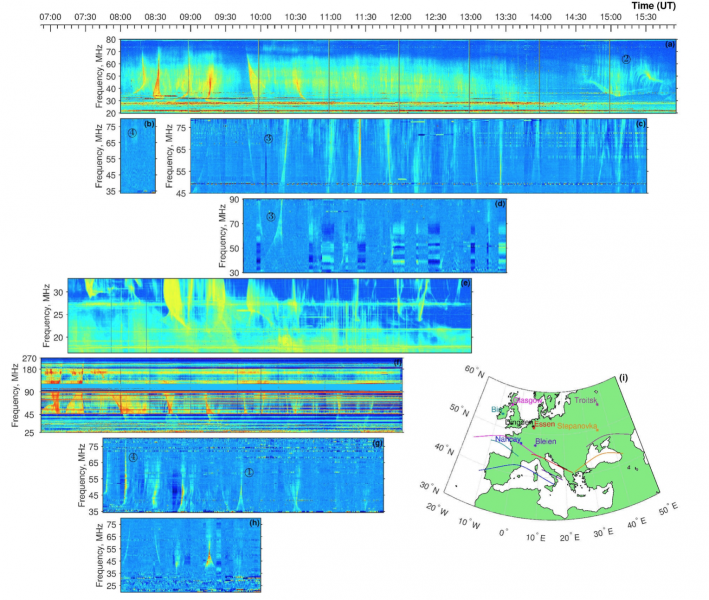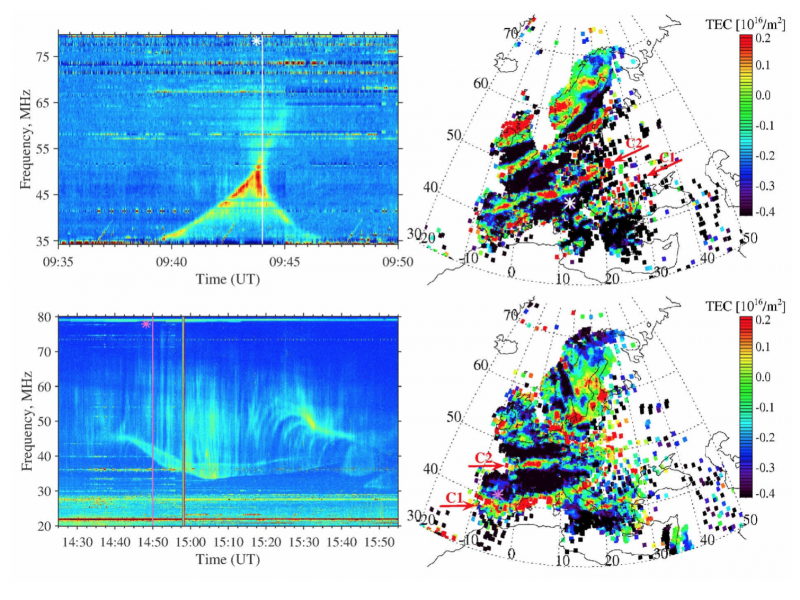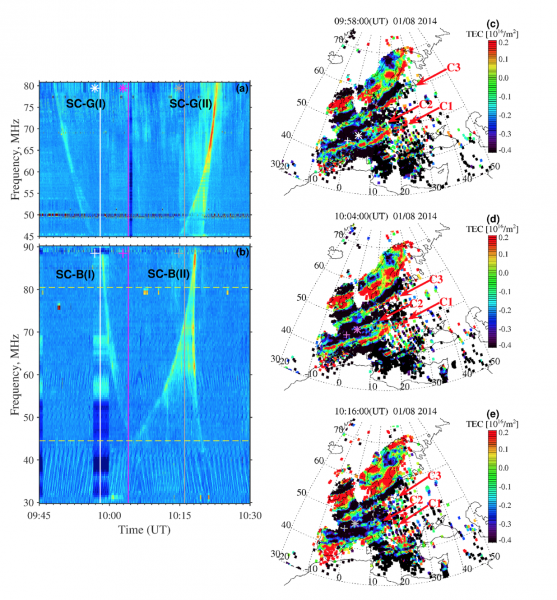The solar radiation focusing effect is related to the specific phenomenon of propagation of the Sun-emitted HF and VHF waves through the terrestrial ionosphere. This natural effect is observed with ground-based radio instruments running within the 10-200 MHz range, as distinctive patterns – the Spectral Caustics (SCs) – on the solar dynamic spectra. On the spectrograms they exhibit unusual morphology and specific time-frequency features (CESRA nugget by Koval et al., 2017). It has been suggested that SCs are associated with medium-scale traveling ionospheric disturbances (MSTIDs) (CESRA nugget by Koval et al., 2019)
Despite the existing studies on the SCs topic (Meyer-Vernet et al. 1981, Koval et al. 2017, 2018), a major challenge remains, which is to capture observationally a specific TID perturbation causing a specific SC. In other words, can we identify a one-to-one – MSTID-SC – correspondence using available data? So far, direct observations of a TID as the cause of an SC have never been reported. To address this challenge we analyze simultaneously-observed solar dynamic spectra and detrended total electron content (dTEC) maps, which have been used as an effective tool in TID studies.
In this paper, we present the first direct observations of SCs induced by MSTIDs using solar dynamic spectra with SCs obtained by different European radio telescopes on January 8, 2014 and simultaneous two-dimensional detrended total electron content (dTEC) maps over Europe. Spatial examination of dTEC maps as well as precise timing analysis of the maps and the dynamic spectra have been performed. First, we found several pairs of one-to-one (TID-SC) correspondences. The study provides strong observational evidence supporting the suggestion that MSTIDs are the cause of SCs.
Results
The solar dynamic spectra from different radio instruments located in Europe have been collected together and presented in Figure 1. In the spectrograms SCs can be recognized by their distinctive spectral shapes. To pinpoint a “parental” TID that causes a SC, we use dTEC maps on which the perturbation component of the ionosphere is represented as a thin layer located at the height of the F2 peak (250 km). For each Sun-antenna pair we obtain the position of the ionospheric pierce point (IPP), that is where the Sun-antenna line of sight crosses the ionosphere layer.

Figure 1. Composition of the time-aligned solar dynamic spectra from NDA (Nancy, France) (a), CALLISTO DARO (Dingden, Germany) (b), CALLISTO GLASGOW (Glasgow, Scotland) (c), CALLISTO BIR (Birr, Ireland) (d), URAN-2 (Stepanovka, Ukraine) (e), IZMIRAN (Troitsk, Russia) (f), CALLISTO ESSEN (Essen, Germany) (g), CALLISTO BLENSW (Bleien, Switzerland) (h) on January 8, 2014. The common time axis is in the range 06:52 UT – 15:55 UT. The scales of frequency axes in dynamic spectra are arbitrary. (i) The map of the antennas locations and IPP tracks associated with the solar observational sessions. The observing sites and the corresponding IPP paths are marked by the same color.
Within the life time of a particular SC, a set of IPP coordinates can be determined and plotted onto the dTEC maps. This allows us to directly observe the instantaneous dTEC structure and the position at which the wave front of incident radio wave penetrates the ionosphere. The focusing can only happen when the solar radio wave propagates through a valley where the refractive index is higher than that in the surrounding crests of TEC perturbation. In Figure 2 and Figure 3 we show several cases where each SC has been identified with specific MSTID, causing the focusing of solar radiation, observationally with great confidence.

Figure 2. (Top) The CALLISTO ESSEN dynamic spectrum with the SC recorded on January 8, 2014. The white solid line on the spectrogram is at 09:44 UT. On the dTEC map on the right, the white asterisk shows the location of the IPP that is in the middle of the valley enclosed by two crests C1 and C2 (red arrows). (Bottom) The NDA dynamic spectrum including the SC detected on January 8, 2014. The purple solid line on the spectrogram is at 14:50 UT. On the dTEC map on the right, the purple asterisk points the position of the IPP, which is within the valley between two crests C1 and C2 (red arrows).

Figure 3. The CALLISTO GLASGOW (a) and the CALLISTO BIR (b) dynamic spectra with two pairs of SCs, SC-G(I,II) and SC-B(I,II), respectively, observed on January 8, 2014. The dashed horizontal lines on the spectrogram in panel (b) show the frequency range of the spectrogram in panel (a). The vertical white, purple, and gray lines indicate three time instants at 09:58 UT, at 10:04 UT, and at 10:16 UT, correspondingly, in both panels (a) and (b). The IPPs relating to the CALLISTO GLASGOW (asterisk) and the CALLISTO BIR (plus) spectrograms for these instants were obtained and plotted on dTEC maps in panels (c-e). The corresponding lines and marks have the same colors. The crests C1, C2, and C3 are pointed by red arrows on the dTEC maps.
Conclusions
In this study, for the first time we provided strong observational evidence of cause-effect relationship between pairs of TIDs and SCs. In all examined cases, the performed timing analysis allowed us to reveal the couplings between MSTIDs and SCs with great confidence. We showed that the observed peculiarities of the spatial structure of TIDs on dTEC maps were consistent with the time-frequency characteristics of the corresponding SCs in the spectrograms. In addition, the study settled a controversy about the origin of SCs in the solar radio records, which may be mistakenly attributed to the Sun. We believe that the SCs topic can be of interests to communities of solar, ionospheric, and plasma physicists, since the studied phenomenon is about the solar radio emission that passes the ionosphere in which TIDs, forming plasma lenses, make the focusing of the incident radiation.
Based on a recently published article:
Koval, A., Chen, Y., Tsugawa, T., et al. (2019). Direct Observations of Traveling Ionospheric Disturbances as Focusers of Solar Radiation: Spectral Caustics, The Astrophysical Journal, https://doi.org/10.3847/1538-4357/ab1b52
References
Meyer-Vernet, N., Daigne, G., and Lecacheux, A., Astronomy & Astrophysics, 96, p. 296, 1981
Koval, A., Chen, Y., Stanislavsky, & Zhang, Q.-H., J. Geophys. Res. Space Phys., 122, p. 9092, 2017
Koval, A., Chen, Y., Stanislavsky, Kashcheyev, A., & Zhang, Q.-H., J. Geophys. Res. Space Phys., 123, p. 8940, 2018
*Full list of authors: A. Koval, Y. Chen, T. Tsugawa, Y. Otsuka, A. Shinbori, M. Nishioka, A. Brazhenko,
A. Stanislavsky, A. Konovalenko, Q.-H. Zhang, C. Monstein, R. Gorgutsa
